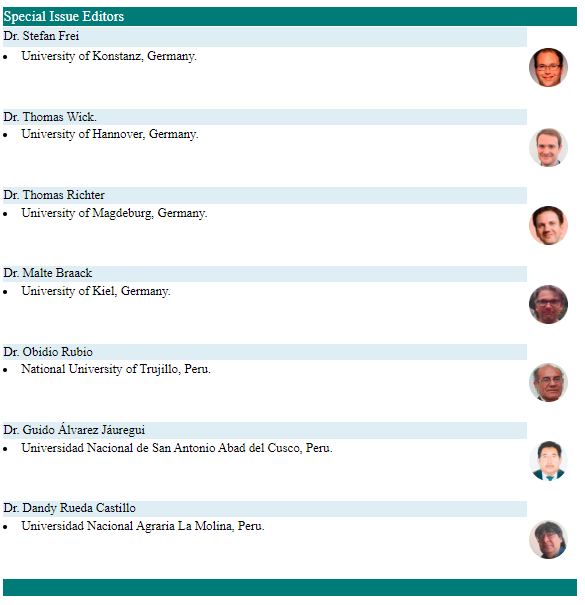Mathematical modeling of injury healing process under the action of an active pharmaceutical ingredient (API)
DOI:
https://doi.org/10.17268/sel.mat.2019.02.14Palabras clave:
Herida, curación, Modelamiento matemático, principio farmacéuticamente active, mecanismoResumen
En este trabajo llevamos a cabo el modelado matemático del proceso de curación de heridas, que es un tema bien documentado en la práctica médica y biológica; pero matemáticamente hablando, todavía hay mucho por hacer para una comprensión clara del fenómeno curativo. Aquí contribuimos al modelado matemático mediante el uso de conceptos de cinética química y herramientas matemáticas, a partir de los cuales hemos podido formular un sistema de ecuaciones diferenciales ordinarias de valor inicial, cuya solución se presenta gráficamente frente a un estudio de caso, donde hemos probado un principio farmacéuticamente activo con respecto a su eficacia. Finalmente, la velocidad del proceso de curación para tal estudio de caso produjo un excelente acuerdo con los datos experimentales, que se han omitido debido a la confidencialidad.
Citas
A. C. de O. G. et Al., Wound healing: Literature Review. 1995; 43(3):221–223.
Dokoumetzidis, A. and Macheras, P. A century of dissolution research: From Noyes and Whitney to the Biopharmaceutics Classification System. Int. J. Pharm. 2006; 321(1–2):1–11.
Eming, S. A., Martin, P. and Tomic-Canic, M. Wound Repair and Regeneration Mechanisms. Sci. TransL Med, 2014; 322(265):265sr6.
Flegg,J. A., Menon, S. N., Maini, P. K. and McElwain, D. L. S. On the mathematical modeling of wound healing angiogenesis in skin as a reaction-transport process Front. Physiol. 2015; 6(SEP):1–17.
Flynn, B. M. E. and Rovee,D. T. Healing Mechanisms. 2015; 82(10):1544–1549.
Geris, L., Gerisch, A., and Schugart, R. C. Mathematical Modeling in Wound Healing, Bone Regeneration and Tissue Engineering. Acta Biotheor., 2010; 58(4):355–367.
Kratz, G. Modeling of wound healing processes in human skin using tissue culture Microsc. Res. Tech. 1998; 42(5):345–350.
Leitao, F., Leitao, S. G., da Fonseca-Kruel, V. S., Silva, I. M. and Martins, K. Medicinal plants traded in the open-air markets in the State of Rio de Janeiro, Brazil: An overview on their botanical diversity and toxicological potential. Brazilian J. Pharmacogn. 2014; 24(2):225–247.
Madhumathi, K. et al., Development of novel chitin/nanosilver composite scaffolds for wound dressing applications. J. Mater. Sci. Mater. Med. 2010; 21(2):807–813.
Palomino-Infante, A. R. Modelling the dynamics of the pulsed isolation of essential oils. in IX Americas Conference on Diferential Equations, 2012; 30–35.
Palomino-Infante, A. R. Pulsed Isolation of Essential Oils Using Pulsed Steam. Ph.D. Thesis, FQIQ, UNMSM. 2016.
Peppas, N. A. and Langer, R. Origins and development of biomedical engineering within chemical engineering. Biomed. Res., 2004; 50:536–546.
Zhang,N., Yan, H. and Wen, X. Tissue-engineering approaches for axonal guidance. Brain Res. Rev., 2005; 49(1):48–64.
Descargas
Publicado
Cómo citar
Número
Sección
Licencia
Los autores/as que publiquen en esta revista aceptan las siguientes condiciones:
- Los autores/as conservan los derechos de autor y ceden a la revista el derecho de la primera publicación, con el trabajo registrado con la licencia de atribución de Creative CommonsAtribución 4.0 Internacional (CC BY 4.0) , que permite a terceros utilizar lo publicado siempre que mencionen la autoría del trabajo y a la primera publicación en esta revista.
- Los autores/as pueden realizar otros acuerdos contractuales independientes y adicionales para la distribución no exclusiva de la versión del artículo publicado en esta revista (p. ej., incluirlo en un repositorio institucional o publicarlo en un libro) siempre que indiquen claramente que el trabajo se publicó por primera vez en esta revista.
- Se permite y recomienda a los autores/as a publicar su trabajo en Internet (por ejemplo en páginas institucionales o personales) antes y durante el proceso de revisión y publicación, ya que puede conducir a intercambios productivos y a una mayor y más rápida difusión del trabajo publicado(Consultar: efecto del acceso abierto).













